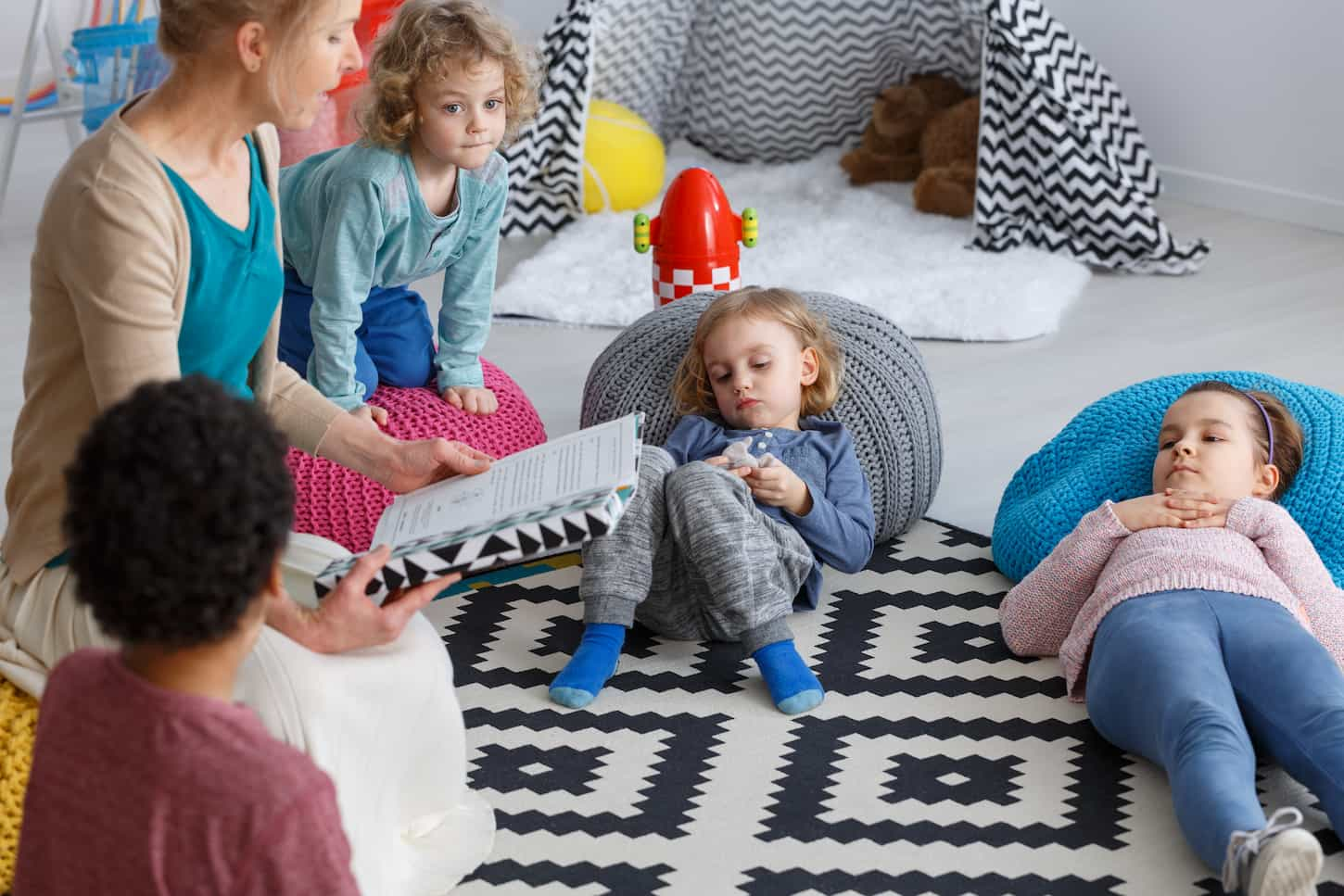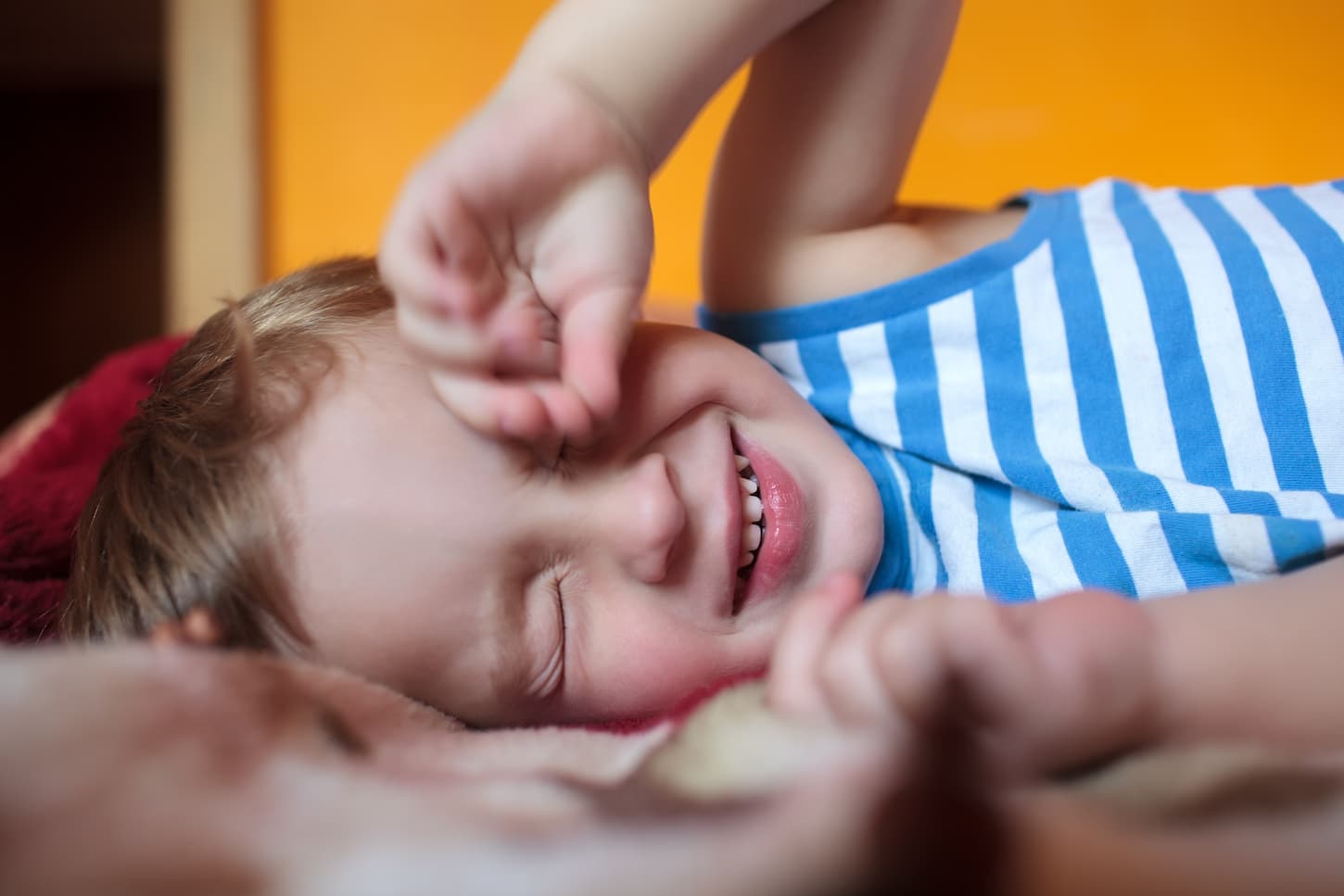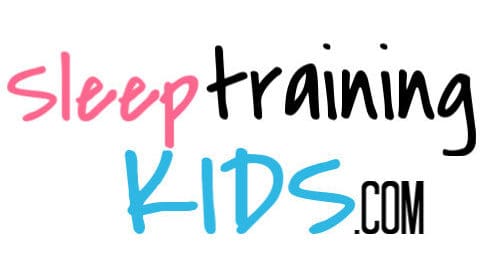Lately, my preschool-aged son has been fighting bedtime hard enough that I’ve been watching (and dreading) a preschool sleep regression. I wondered if that’s even a thing, so I dove back into research mode.
Preschool-aged children can experience sleep regressions due to growth and reaching developmental milestones, although fear and anxiety are more likely causes. These sleep disruptions require parental intervention or they may become long-lasting sleep problems.
Ready to talk about sleep regression preschool style? Here are 25 things to know.

Why Sleep Regressions Happen to Preschoolers
Preschoolers are still growing and developing – and a lot of that growth is happening where it’s hard to see. They’re learning to play pretend as well as how to play with other people. They’re transitioning from playing next to children to playing with friends and even playing pretend.
During this time frame, they’re also realizing that the world isn’t as safe as they once thought it was. Thankfully, though, most of their fears are still in the form of “the monsters will get me when I flush the potty!!” variety.
Even so, preschool-aged children are beginning to develop fears and maybe increased separation anxiety – as well as just generic anxieties and fears.
With the emergence of these anxieties and fears, sleep naturally becomes harder. Sometimes that means bedtimes and sometimes that means an increased amount of night wakings (due to nightmares).
Whatever the case, this increase in anxiety (due to normal development) may cause sleep disruptions and sleep regressions.
Easier-to-See Reasons for a Preschool-Aged Sleep Regression
Want to see some easier reasons why your preschooler may be experiencing sleep regression? Here you go – and here are also a few ideas of what you can do about it.
| Reason | Description (and Examples) | What You Can Do About t It |
|---|---|---|
| Bad Dreams | Bad dreams may cause your child to wake up at night. Or the fear of bad dreams may make bedtime a nightmare! | Identify and eliminate triggers that may be causing bad dreams, including dietary and activity-based triggers. |
| Night Terrors | Night terrors happen when overtired children don’t fully wake up after a nap or in the night – and the screaming is awful. There’s not much you can do until they wake up – or settle back to sleep (whichever comes first). | Use early bedtimes for a few nights to get your child’s sleep back on track. Expect a few rough days. |
| Naps are Outgrown | Outgrowing naps may result in an over-exhausted child unless bedtimes are adjusted frequently until their new sleep schedule normalizes. | Use earlier bedtimes on days when no naps happen – and regular bedtimes if naps do happen until they graduate naps completely. |
| Hunger or Thirst | Thirsty or hungry preschoolers may fight sleep until they get enough calories or drink to satiate their tummies. | We let our kids have a sippy cup of water in bed to prevent dehydration, as we do live in a desert. We may also let hungry kids have a high-protein shake before bed. |
| Enuresis (Bed Wetting) | Bedwetting may cause nighttime waking – or may make bedtime difficult if they’re afraid of wetting the bed. | Until our kids are fully nighttime potty trained, we use nighttime pull-ups to prevent this issue and protect sleep quality. |
| Misplaced Toys | Lost stuffed animals, toys, blankies, or lovies may trigger a nighttime tantrum or wake-up call. | We try to limit the number of toys and lovies in bed to minimize these types of disruptions. |
| Bedroom Changes | Bedroom furniture changes may trigger sleep regressions while your child adjusts to the new normal, especially if it involves a new bed! | We talk up any bedroom changes for days (or longer) before they happen – and if possible, we set up the new furniture for a few days before using it. |
| Room Sharing with Siblings | Roommate changes may also require a transition period – while the kids get used to their sibling’s sleep noises or the lack thereof. | We expect a few rough nights (and early bedtimes) when there’s a roommate swap. |
| Fear of Monsters | Monsters may not be real, but the fear of them will definitely impact your child’s sleep. | Our kids believe that monsters are allergic to and scared of our pet dog and cat. |
| Sleepwalking | Sleepwalking may manifest. It may be caused by or cause sleep disruption. | Be sure to talk to your pediatrician if your child exhibits signs of sleepwalking. |
| Illnesses | Getting sick stinks, but it’s part of growing up and preschool life. Illness may or may not impact sleep, depending on the severity and type of the illness. | If needed, talk to your doctor about how to manage the symptoms so they are less disruptive to sleep for everyone. |
| Underlying Medical Concerns | Children with underlying medical concerns will see their sleep impacted. | Be sure to talk to your healthcare team to address these underlying concerns to the best of your ability. There may be residual problems despite your best efforts. |
| Not-Exhausting Days | Not tired enough from regular daytime activities. This could translate into a child who fights to fall asleep – and then that triggers sleep disruption and regression from staying up too late. | Plan fun, exhausting days – even if that means playing at the park or spending time playing in the backyard. |
| Fear of Missing the Fun | FOMO (fear of missing out) on all of the fun, after-bedtime activities may keep your child up at night – especially if they can hear the fun! | That’s part of why we use a white noise machine – to help eliminate any distracting noises and FOMO our children may have. |
| The Wrong Bedtime Routine | Paradoxical bedtime routines may inadvertently cause sleep regressions. This can happen if bedtime routines include activities that rile up children rather than soothe them into a sleepy mode. | Change up the bedtime routine to something simpler, calmer, and more relaxing. Then, use early bedtimes for a few days to get back on track. |
| The Bedtime Pop-Up Game | Getting out of bed frequently, whether right at bedtime or in the middle of the night may also trigger sleep regressions. Getting up to report sibling behavior or ask for more water (or whatever reason) is impacting their sleep quantity and quality. | It’s a delicate balance of addressing the reason while also enforcing boundaries to protect sleep. |
| Nighttime Wakings | Night wakings, in general, are a problem as those impact sleep, too. Many times this may be caused by a nightmare, even if it ends in your preschooler climbing into bed with you. | This is also a balancing act as you need to address the underlying concern while also getting back to bed ASAP. |
| Wanting to Snuggle Mom & Dad | Sometimes, kids just want to climb into bed with mom and dad. Some of these kids develop amazing, ninja-like skills at climbing into bed unnoticed. | This may only be an issue if it causes family-wide sleep disruption or the family decides it’s a problem. Try fading sleep training to fix this. Other families may just let it go and co-sleep for the time being. |
Preventing Sleep Regressions for Preschoolers
Is it possible to prevent every sleep regression in preschoolers? Maybe. It’s sure easier to do so at this age than at earlier ones – if only because your preschooler can talk. At this age, they can start telling you what they’re afraid of or what’s keeping them from sleeping well.
So if your preschool-aged child is telling you about a new fear of the dark (or flushing toilets), be proactive in addressing those fears and anxiety triggers.
Doing so will help prevent sleep issues and disruptions.
Not All Preschoolers Have Sleep Disruptions
Now, it’s important to note that not every preschooler will experience sleep disruption, even if they do have fears and anxieties. This could be for one of several reasons.
- First, these children may already have a solid sleep foundation (whether thanks to you or naturally) that they’re able to set those fears aside and sleep.
- Second, issues could be totally daytime related, meaning that there are no nighttime issues that trigger sleep problems.
- And finally, it could just be good luck or good timing. Yes, it’s possible!
In any case, not every preschooler will have sleep issues related to sleep regression. Some, however, will.

How Long Do Sleep Regressions Last for Preschool Kids?
Typical sleep regressions for babies can last as long as several weeks (anywhere from 2-6 weeks, on average). For preschoolers, the length of their sleep disruption will depend on the triggers as well as how the issue is being addressed.
For example: our second boy experienced a preschool-aged sleep regression that was triggered by a fear of fireworks. Given how infrequently fireworks are an issue, it took us 2-3 YEARS to fully address that fear – and help him sleep well when there were fireworks. Now that same boy absolutely loves fireworks.
When Preschool-Aged Sleep Disturbances End
Officially, preschool-aged sleep regression ends when sleep has returned to a sustainable, reliable, and regular pattern. This may take some time and will depend on the trigger.
Remember our boy who was afraid of fireworks?
We were able to get our boy back to a regular sleep pattern within a few days of each night of fireworks. So the individual sleep regression was easily and quickly addressed. However, the underlying fear (that triggered sleep disruption) took much longer to address.
We’ll talk more about what we did to help him to overcome this particular fear later on. Because we came up with a pretty cool solution to help him overcome the issue – and officially end this awful sleep disruption trigger.
Signs and Symptoms of Sleep Regressions in Toddlers and Preschoolers
Preschool-aged children may show some more interesting signs and symptoms of exhaustion (and sleep regression).
- Increased crankiness during the day
- Fear of sleep
- More periods of quiet playing than usual
- Frequent nighttime waking
- Increased fear of or fighting at bedtime
- Appetite changes
- Less frequent napping (although this may also be a sign that naps are being outgrown)
- Night terrors
- Behavioral regressions
- Increased frequency or volatility of tantrums
- More cuddling
- Spacing out while sitting still
- Increased eye-rubbing, yawning, or other sleepy signs
- Dozing off after fighting sleep
- Falling asleep in the car (when they usually don’t)
My preschool-aged children are far more cuddly when they’re experiencing sleep disruptions (or just poor quality sleep). They are also far more likely to doze off while being held if we’re watching a movie for an inpromptu “rest time” after lunch.
What To Do About Sleep Regressions and Preschoolers
Need some ideas to help you manage preschool-aged sleep regressions? We already talked about quite a few earlier in the article – please refer to the table in the section titled “Easier-to-See Reasons”.
Even so, let’s discuss more areas that can be evaluated, why that is, and what we can do about them. We’ll even cover some of the previously-discussed reasons in more depth or from a different perspective. Ready?
| Evaluate This | Rationale | How to Improve the Situation |
|---|---|---|
| Look at activities between dinner and bedtime. | Rough and rowdy activities, sugar-rich snacks, or too much screen time close to bed can affect sleep quality and quantity. | Transition to activities that encourage preparation for bedtime: reading, board games, bathtime, or snacks that won’t give your kids a sugar rush. |
| Are bad reams or night terrors an issue? | Bad dreams and night terrors will affect naps and nighttime sleep. | Identify and address any issues that may be impairing sleep, like fears of monsters. |
| Does your child have a healthy sleep routine? | As your preschooler outgrows naps and continues to grow, their sleep needs will change. Be sure to build their schedule to meet their sleep and other needs as they grow and develop. | Create a bedtime routine with your preschooler and give them some choices so that bedtime (and sleep) become a happy family activity instead of a dreaded one. |
| Is your child’s room a positive sleep environment? | What kind of bed is your child sleeping in? Do they get to have stuffed animals, sippy cups of water, or other items in their bedroom? What toys and activities stay in their room? | Consider adding items that promote sleep and removing those that distract your child from sleeping. (We added sippy cups and removed toys) |
| Is bed wetting (enuresis) a problem? | Bedwetting may be caused by fears, anxieties, or deep sleep (an inability to wake up and use the toilet that is normal for some children up to as old as 6-10 years old). | Set your child up for a successful night. Consider talking to your pediatrician and/or using nighttime pull-ups. |
| Are fears and anxieties taking over? | Many children who stall at bedtime are afraid of something – but may not know how to voice their fears, let alone address them. | Talk with your child at bedtime and ask them if there are issues or concerns. Be patient while they figure it out and respond. |
| What is your before-bed reading material like? | What books are you reading before bedtime (or during bedtime routines)? Are these books causing fears, concerns, or exciting your children too much right before bed? | Switch to calmer books that encourage and promote sleep. Or even consider changing reading time to another time during the day. |
| Are there recent changes? | Changes can cause anxiety until your preschooler adjusts. | Give your child time to adjust and talk them through it. Give them reasons and answers as needed. |
| Does your preschooler want a rationale? | Preschoolers are smart – and many of them want actual reasons why things happen. | Go ahead and give your child simple but logical reasons as to why. This may be as simple as, “Your body needs enough sleep tonight so you’ll have the energy to play. Goodnight!” |
| Are there underlying or hidden medical concerns? | If other answers aren’t working, there may be a hidden or underlying medical concern that may need addressing. | Talk to your pediatrician about your concerns. Together, come up with a solution or testing as needed. |
| Is your child afraid of missing out on something? | Children who love being involved will have a harder time stopping and getting away to go to bed. | Create a positive sleep environment and consider using a white noise machine to help them block out the noises that distract them from sleeping. |
| Is your child getting up to ask for one more thing? | Check with your child each night to make sure they have everything they need. | After making sure that your child has everything at bedtime, consider using a wake-up clock so they know when it’s okay to wake up and come out in the morning. |
| Is your child sneaking into your bed? | Ninjas who sneak into your bed may have fears and anxieties that need addressing – or they may just want to sleep with you. | You may want to consider co-sleeping. Or you may have to consistently walk your child back to bed for nights on end. Either way, implement what’s right for your family and be patient. |
Dealing with preschool-aged sleep regressions isn’t easy. It requires lots of patience, consistency, and more patience. But it is possible. For more tips on how to use age-appropriate sleep training to manage this sleep regression, be sure to read my article on sleep training big kids.

Tips to Break Negative Sleep Associations
If your preschooler has a negative sleep association that’s impacting their sleep (or has recently developed one), it very well could be contributing to this sleep regression – if not causing it.
The best way to break that negative sleep association is with a behavioral sleep training technique and time.
The behavior-based sleep training technique that has worked best for us when it comes to breaking negative sleep associations is called fading.
The reason why I recommend fading is that it helps your preschooler break negative sleep associations while also giving you time to address any other underlying concerns (like fears and anxieties) that could be making the sleep regression worse.
- To read more about positive, negative, and external sleep associations, read my article on how sleep associations and regressions are related here.
- Or to read more about how to fade it out, read my article on fading.
- Not sure fading is right for you? Read my article on the best ways to sleep train big kids (available here) – including how to adjust your favorite method so it’ll work.
Create a Positive Sleep Environment for Your Child
To help this sleep regression end already, it’s key that you have a positive sleep environment for your preschooler. Having a positive, sleep-ready space for them will also help prevent future recurrences.
As a general rule, people sleep better in dark, quiet, boring, safe, and comfortable spaces. So do what you can to create that kind of a sleep-promoting environment for your children.
We keep most toys and books outside of bedrooms. We do let our preschool-aged and older kids take a book to bed that they can look at (or read) for a few minutes in addition to their blankie or favorite stuffed animal. Just make sure any nightlights or flashlights have a timer – so they turn off without your assistance.
We also use things like white noise machines, blackout curtains, and wake-up clocks to create an ideal sleep environment. Click here to see which products we use and recommend in our kids’ rooms.
Routine is Key to Survival
Preschool-aged kids still rely on routines to thrive. And that’s okay. So stick to your routine as much as possible – while also being flexible as needed in order to survive the day. Use what works – and ditch what doesn’t.
Be patient. Know that your routine will come back. Just be patient, persistent, and keep moving forward.
Generally speaking, we were able to stick to most of our routine during a preschool-aged sleep regression. I did find that bedtimes had to be moved forward – and after lunch, a “rest time” became mandatory, even if no napping happened.
Then, when things settled down a few days or weeks later, we could slide back into our regular routine.
What Time Your Preschooler Should Go to Bed (and how much sleep they need
After lots of research, experimenting with how much sleep our kids and talking to thousands of other parents, here’s what we’ve found as far as how much sleep a preschool-aged child needs – and guidelines for a good bedtime.
| Age | Number of Naps | Average Length of Naps | Wake Time Between Naps | Bedtime | Nighttime Sleep Requirements | Sleep Required Each 24 Hours |
|---|---|---|---|---|---|---|
| 18 Months to 3 Years | 1 | 1-2 hours | N/A | 7-8 PM | 10-12 hours | 11-14 hours |
| Preschoolers | 0 | N/A | N/A | 7-8 PM | 9-12 hours | 9-12 hours |
| Grade Schoolers | 0 | N/A | N/A | 7-8 PM | 9-12 hours | 9-12 hours |
For reference, I’ve included the ages around a preschooler, too. I find that having that helps me to remember that these are averages – they aren’t hard-and-fast rules. Some children will need less sleep – and others will need more.
Even so, having these averages on hand is a huge help and reference point, especially as kids grow.
As preschoolers, my kids all need about 12 hours of sleep at night with no daytime naps.
Adjust Bedtime (and Wake Up Time) as Needed
Now that you know the average bedtimes suggested for a preschooler (and their total sleep requirement averages), you can use that information to guide you to finding something that works better. Or at least something that helps you survive this preschool-aged sleep regression better.
These aren’t rules set in stone, after all. They’re guidelines and averages. So feel free to adjust as needed and find what works for you – especially as far as bedtimes and wake-up times go.
Just keep in mind that, for most kids, it’s far easier for bedtimes to be adjusted than it is for wake-up times.
In fact, my kids will only ever “sleep in” if they’re quite ill. So we keep the same wake-up times – unless kids are sick and need the extra morning sleep.
Instead, just adjust the bedtime to a few minutes earlier if needed.
My preschool-aged kids, while in the midst of some sleep disruption or sleep regression, may need their bedtime moved 15-30 minutes earlier than our usual bedtime. Once sleep has normalized, bedtime goes back to its “usual” time.
So take the averages and guidelines from the previous section and use them to find what works for your child – and to better manage this sleep regression so it ends already.
Say “So-Long” to Naps
After extensive research and life experience, I’ve found that most preschool-aged children no longer take naps. There may be some who still take naps, but that’s not the general rule.
So if your preschool-aged child is still napping, know that those days will end soon. And, depending on daycare or school, those days may need to end sooner rather than later. Of course, that may depend on your daycare or school’s scheduling, as some still have nap times. Be sure to talk to the school or facility for details.
Either way, though, be prepared to leave naps behind here soon. And if you haven’t already, use a gradual approach to do so.
- On days when your child takes a nap, use a regular bedtime.
- On the other days when there are no naps, use an earlier bedtime to help your child adjust and get enough sleep.
- Alternate as needed until no naps are needed.
- Titrate (or experiment with) bedtime as needed once naps are gone to see if the timing of going to bed can be changed without impacting sleep – or triggering another regression.
Dealing with Fears and Anxiety in Sleepy Preschoolers
Ready to help your child deal with those fears and anxieties that may be triggering or worsening this sleep regression? Let’s do it!
Dealing with different fears will require different approaches. That’s totally normal and expected. So you may need to play things by ear.
Remember my boy who didn’t like fireworks? We talked with him about addressing those fears. Here’s how we helped him.
Dealing with a fear of fireworks was hard to do, simply because they are an infrequent occasion. But we did discover a helpful hack that sped things up: YouTube. We were able to watch videos of fireworks to help desensitize him to the loud noises while controlling the volume – and that’s how we finally helped him overcome that fear.
So if your child has a strange fear that’s triggering sleep regression, see if you can find a related video on YouTube to help your child adjust. Just be sure to watch it first and make sure it’s age-appropriate for your child. Then know that your child may develop a love of watching fireworks displays (or whatever else) on YouTube.
The other big fear and anxiety we’ve had to deal with is FOMO: the fear of missing out. My preschoolers hate missing out on all the fun that happens after they go to bed!
We help our kids manage their FOMO by using a white noise machine and keeping their bedroom doors closed. The white noise helps soothe their brains and block out extra noises that might otherwise make them believe they were missing out on the fun.
That way, we can still do our things after kids are in bed – and not have to deal with FOMO disrupting our kids’ precious sleep.
There will be other fears to deal with – and that’s totally normal. Here are some others we’ve dealt with up to this point.
- Fear of monsters/robbers/bad guys. Our kids decided that robbers/bad guys/monsters are allergic to our dog and cat – and that it’s the animal’s job to keep kids safe (particularly from monsters). We just kinda went with it.
- Fear of flushing toilets. This is a fear I remember having as a kid. It’s a weird one that needs time and no bugs being visibly flushed down the toilet to get over.
- Fear of bugs. Yup: bugs. We tell our kids we have a “no bugs in the house” policy – and then we enforce it. It helps that our cat actually eats any bugs she finds.
- Fear of wetting the bed. We’d rather deal with prolonged nighttime potty training than let a fear of bedwetting cause sleep disruption. Pull-ups are a lifesaver for us.
- Fear of being afraid. We talk to our kids about how we’re always here for them – and that our Heavenly Father is always here for us, too. We practice praying and using some deep breathing to keep this fear under control.

Keep Daytime Active and Fun
It’s hard to have a good night’s sleep if you didn’t do anything all day, even as an adult. So help your kids stay active during the day – so that their sleep is restorative and restful.
Get outside. Be active. Our pediatrician is fond of telling our kids that:
There’s no such thing as bad weather. There’s only inappropriate clothes. So put on the right clothes and go outside to play!
Our pediatrician
Daytime activities don’t have to be elaborate or expensive. Just go play in the backyard. Go dig in a sandbox or play tag. Make some playdough or draw with sidewalk chalk.
Just get out and do something active and in the sunlight. That way, you’re helping reinforce natural circadian rhythms while also exhausting your child so they’ll sleep well tonight.
Practice Sleep Training Skills with Your Preschooler
It’s never too late to implement and practice good sleep hygiene skills. One of the best ways to do that is with behavior-based sleep training.
We still practice “sleep training” our big kids – to teach them good sleep habits for life. They think it’s just part of the regular routine – and that’s just fine by me!
Part of that is by talking to your preschooler about how to sleep and all of the things that need to be in place so we sleep well.
For more information on how to talk to your preschooler about how to sleep well, see my article on teaching big kids to sleep well with sleep training.
Have a Plan for Surprise Nighttime Visits by Sleepy Preschoolers
Hopefully, you aren’t dealing with preschoolers who have ninja-like skills when it comes to sneaking into your bed. However, it does happen. So if you are experiencing some surprise nighttime visits from your preschoolers, there are several options.
- Let it go – and just co-sleep as needed for now.
- Give it a few days to see if it self-resolves.
- Use a “thousand-walk” or fading method to put them back to bed as soon as they’re found out.
Getting a preschooler to adjust back to their own bed probably won’t happen overnight – unless it really was a freak, one-time fear (like a brutal thunderstorm) that drove them to your bed.
Remember my preschooler who was terrified of fireworks? Yeah, he ended up in our bed frequently after the 4th of July.
So on holidays that had fireworks, we just expected him to show up wherever we were. We didn’t do anything about it until the fireworks show ended – and then we’d ease him back to his bed.
Once we were able to address the underlying fear, he naturally stayed in his own bed.
However, I have friends whose kids just love to snuggle. So if there’s no underlying fear, then I’ve seen that a fading, behavior-based sleep training method has been the only sure-fire way to fix the unwanted, nighttime visits.
Ask Your Village for Help as Needed
It’s okay to ask for help when things are difficult. And if this preschool-aged sleep regression is difficult? Ask for help. It’s okay.
Ask friends and family for help. Talk with your spouse or partner and see how you can help each other. Maybe take turns taking naps on days off.
In any way you can do so, ask for help. Then, accept the help that can be given.
Go to Bed Early (and take care of yourself!)
When your preschooler is going to bed early to combat sleep disruption, consider going to bed early yourself. Going to bed early is a great self-care option for anyone who’s tired!
Even if it’s just for a few nights, go to bed early. It’ll help you feel better and more normal – especially after a few rough days and nights with that cranky child. And it’ll make surviving tomorrow much more doable and bearable.
Watch Your Preschool Child for Cues that They’re Sleepy
Not sure if naps or bedtimes are the right time? Adjust as needed based on sleep cues. However, sleep cues can be a funny thing – and they may have changed since your preschooler was a toddler.
Here are some of the typical sleep cues:
- Increased cuddliness
- Increased impatience
- Staring off into space (disinterest)
- Rubbing eyes
- Increased levels of crankiness
- Tantrums
- Screaming
- Fighting sleep
- Generally being unreasonable
The exact order or cues will vary from child to child. So keep track of the early sleep cues – and which ones are the “too late!” sleep cues. That way, you can help your child get enough sleep.
Even with my preschoolers, the first sign of tiredness is an increase in cuddliness. Eye-rubbing is a middle-tier sleep sign that screaming and tantrums are coming – and I’d better use the shorter bedtime routine.
Be Patient at Night – and Practice Sleeping
Nights may be difficult for a few days, but that doesn’t mean all hope is lost. Just look at these next few nights as a practice run – at sleeping. Things will get better, especially as you use those early bedtimes to your advantage.
So be patient – especially at night. Keep trying to practice sleeping. Eventually, everyone will settle back into the normal routine and sleep again.
Teach Your Child to Take 5 Minutes and Calm Down – by Doing it Yourself
Dealing with cranky preschoolers can be exhausting. But now that they’re able to understand more, teach them to take five minutes to calm down. Do some deep breathing together – before and after you do some yourself, of course!
Taking a few minutes (as needed throughout the day) to center yourself with mindfulness, guided imagery, meditation, or deep breathing is also a great way to help you survive the whole day.
Do what you need to in order to stay calm. It’ll help a ton.
Be Patient with Exhausted Preschoolers
Being a kid isn’t easy. There’s so much to learn and do – and it’s so easy to get distracted and frustrated. So as you’re dealing with an exhausted, cranky, or downright awful day with your preschooler, be patient with them.
This awful period will pass – eventually. It will take dedicated effort, love, patience, parenting, and maybe even some big-kid style sleep training. But it will pass – as long as you’re actively working to improve things and being patient throughout the process.
And then remember to cut yourself some slack – and be patient with yourself. It’ll make the whole process much, much easier!

Be Flexible During a Difficult Transition
Sleep regressions aren’t a permanent thing, even for preschoolers. They’re part of growing up and are a transition. So be flexible during this time of intense, sleep-deprived change.
Go with the flow. If one day your preschooler needs a nap, go with it. If one day they need a nap AND an early bedtime, that’s fine, too.
Do what you need to for everyone, yourself included. You’ve got this.
